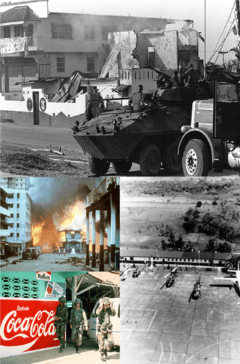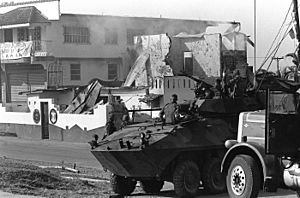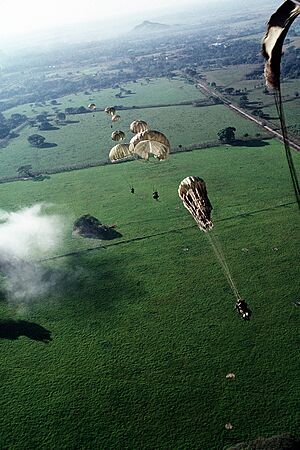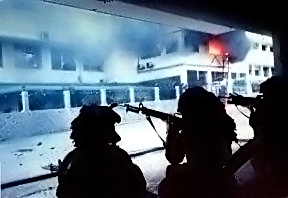United States invasion of Panama facts for kids
Quick facts for kids United States Invasion of Panama |
|||||||
|---|---|---|---|---|---|---|---|
| Part of the War on Drugs and the Cold War | |||||||
 Clockwise from top:
|
|||||||
|
|||||||
| Belligerents | |||||||
| Commanders and leaders | |||||||
| Strength | |||||||
| 16,000 | 27,000 | ||||||
| Casualties and losses | |||||||
| 314 killed 1,908 captured |
23 killed 325 wounded |
||||||
|
Panamanian civilians killed according to: |
|||||||
The United States Invasion of Panama, also known as Operation Just Cause, was a military action that took place from December 1989 to January 1990. It happened when George H. W. Bush was the President of the United States. The main goal of the invasion was to remove Panama's leader, General Manuel Noriega, from power.
This event took place ten years after the Torrijos–Carter Treaties were signed. These treaties planned to give control of the Panama Canal from the United States to Panama by the year 2000. After the invasion, the Panama Defense Forces (Panama's military) were disbanded. Guillermo Endara, who had won the election, became the new president. Some international groups, like the United Nations General Assembly, said the invasion broke international law.
Contents
Why the Invasion Happened
The United States had many military bases in the Panama Canal Zone. These bases were there to protect the Panama Canal, which was very important for shipping. In 1977, U.S. President Jimmy Carter and Panama's leader, General Omar Torrijos, signed the Torrijos–Carter Treaties. These treaties planned for Panama to take full control of the canal by 2000. Even with the transfer, the U.S. wanted the canal to stay open for American ships.
Noriega's Relationship with the U.S.
General Noriega had a long history with the U.S. He worked as an informant for the Central Intelligence Agency (CIA) from 1967. This included the time when George H. W. Bush was head of the CIA. Noriega helped the U.S. in Central America, for example, by working against the Sandinista government in Nicaragua. He received money from the U.S. for his help.
Relations Get Worse
In the mid-1980s, things started to go wrong between Noriega and the U.S. President Ronald Reagan asked Noriega to step down after he was linked to some scandals. Noriega refused to leave. Some U.S. officials wanted to invade Panama, but Reagan said no.
Noriega then seemed to become friends with countries that were against the U.S. during the Cold War, like Cuba and Libya. Because of this, U.S. military planners started making plans for a possible invasion of Panama.
In May 1989, Panama held national elections. An alliance of parties against Noriega said their candidate, Guillermo Endara, won by a lot. Noriega's supporters attacked Endara the next day. Noriega then canceled the election results and stayed in power by force. This made him very unpopular with many Panamanians. The U.S. President Bush told Noriega to respect the election results. The U.S. also sent more soldiers to the Canal Zone.
In October 1989, Noriega stopped another attempt by parts of the Panama Defense Forces to remove him. Pressure on President Bush grew. Bush said the U.S. would not negotiate with Noriega. On December 15, Panama's government declared that a state of war existed with the United States.
Efforts for Peace
Before the invasion, leaders from nearby countries tried to find a peaceful solution. Presidents from Costa Rica, Venezuela, and Colombia, and the Prime Minister of Spain, all met with Noriega in secret. They tried to convince him to leave power and go live in Spain, but he would not agree.
Why the U.S. Said They Invaded
President George H. W. Bush explained the reasons for the invasion on December 20, 1989, just hours after it started. He said Panama's declaration of war and attacks on U.S. troops were reasons for the action.
Bush also listed four main goals for the invasion:
- To keep U.S. citizens in Panama safe.
- To support democracy and human rights in Panama.
- To fight against the illegal drug trade.
- To protect the Torrijos–Carter Treaties and the Panama Canal.
These reasons helped get support for the invasion from both major political parties in the U.S. The invasion was quick and successful, and most Americans supported it.
Military Actions
The military action in Panama began on December 20, 1989, at 1:00 a.m. local time. About 27,684 U.S. soldiers and over 300 aircraft were involved.
The operation started with attacks on important places. These included the Punta Paitilla Airport in Panama City and a military base at Rio Hato, where Noriega also lived. U.S. Navy SEALs destroyed Noriega's private jet and a Panamanian gunboat. Military command centers across the country were also attacked.
Fort Amador was taken by U.S. soldiers in a nighttime air assault. This fort was important because it was near large oil storage areas, the Bridge of the Americas over the canal, and the Pacific entrance to the Panama Canal. It also had many U.S. homes that needed protection from Noriega's supporters.
A few hours after the invasion began, Guillermo Endara was sworn in as president at Fort Clayton. He was considered the winner of the election earlier that year.
Noriega's Capture
Operation Nifty Package was a special mission by Navy SEALs to stop Noriega from escaping. They sank his boat and destroyed his jet. Noriega was on the run for several days. But with a huge search for him and a $1 million reward for his capture, he sought safety at the Vatican embassy in Panama City. The U.S. military put pressure on him and the Vatican. Noriega finally gave up to the U.S. military on January 3, 1990. He was then flown to the U.S.
What Happened After

Guillermo Endara, who had been in hiding, became president just before the invasion. Years later, he went on a hunger strike to highlight the poverty and homelessness that resulted from Noriega's rule and the U.S. invasion.
Many businesses in Panama filed a lawsuit against the U.S. government. They said the U.S. action damaged their property. Most businesses had insurance, but the insurance companies often refused to pay, saying acts of war were not covered.
About 20,000 people lost their homes because of the fighting, especially in areas like El Chorrillo. The U.S. gave money to about 2,700 families to help them build new homes.
On the first anniversary of the invasion, many Panamanians marched to protest the U.S. action and the new government's policies. They claimed that thousands of people died because of the U.S. military action.
Since Noriega was removed, Panama has held several presidential elections, with different parties winning. In 1990, the new government ended Panama's military. In 1994, a change to the constitution permanently abolished the military in Panama. Panama's economy recovered by 1993, but many people still faced unemployment.
Noriega was taken to the U.S. for trial and was sentenced to prison.
Other Operations
- Operation Nifty Package: This mission by Navy SEALs aimed to capture Manuel Noriega or stop him from escaping. They destroyed his private jet and gunboat.
- Operation Nimrod Dancer: This operation sent more U.S. troops to Panama to strengthen forces already there.
- Operation Promote Liberty: This operation aimed to help rebuild Panama's military and its public services.
- Operation Purple Storm: This operation showed and practiced the U.S. military's right to move freely in and around Panama.
- Operation Sand Flea: Similar to Purple Storm, this operation also showed and practiced U.S. freedom of movement.
- Raid at Renacer Prison: A military operation where a prison was taken over, and 64 prisoners were rescued.
See also
 In Spanish: Invasión estadounidense de Panamá para niños
In Spanish: Invasión estadounidense de Panamá para niños





